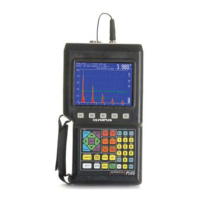92
EPOCH 4PLUS
9.4.3.3 Transfer Correction
Transfer Correction is an adjustment in the Reference Gain setting during calibration of
the instrument and is typically added when the surface conditions between a calibration
block and test piece are different. The coupling conditions on the test surface can often
cause signal loss after calibrating a DAC curve, which results in inaccurate comparisons
of the test reflectors with the calibrated DAC curve. The EPOCH 4PLUS can easily adjust
for this potential difference by adding transfer correction into the calibrated base gain after
completing the DAC curve setup.
To add transfer correction to a completed DAC curve, follow the steps below:
1. Press the GAIN key.
2. Select either a 0.1 dB or 6 dB adjustment increment using the [F1] or [F2] keys,
respectively.
3. Use the UP and DOWN slewing keys to adjust the scanning gain by the desired
increment. The scanning gain is displayed at the upper left of the screen, next to the
calibrated base gain level.
4. Once the desired scanning gain is displayed, press the ADD Function Key [F3] to add
the scanning gain to the base gain and apply the transfer correction.
Note: The gain increment values assigned to the [F1] and [F2] keys can be
customized using the Editable Parameters feature. See section 3.4 for details.
9.4.4 ASME, ASME-3 and JIS Options
9.4.4.1 ASME and ASME-3
The activation, use, and features of the standard ASME and ASME-3 DAC software are
described in section 9.2 of this manual. They are identical in their basic functionality to the
ADT software option.
Advanced DAC/TVG provides more flexibility even with these standard functions. With
each option, ADT offers the ability to toggle between a DAC view and a TVG view after
setting up the initial DAC curve. This toggle function is accomplished after completing
the DAC curve by using the [F1] key, which allows the user to select either DAC or TVG.

